It is unclear what precisely Moscow put on its list or if it is prepared to hold peace negotiations with Kyiv before they are accepted.
According to two people with knowledge of the situation, Russia has given the US a list of demands for an agreement to halt its war against Ukraine and mend fences with Washington.
What Moscow put on its list and whether it is prepared to hold peace negotiations with Kyiv before they are accepted are unclear. According to the persons, during the past three weeks, Russian and US officials have spoken face-to-face and virtually about the terms.
They said that the Kremlin’s requests were similar to those it had previously made to NATO, the US, and Ukraine and that they were wide.
These previous conditions included Kyiv’s exclusion from NATO, a pledge to refrain from sending foreign forces into Ukraine, and worldwide acceptance of President Vladimir Putin’s assertion that Crimea and four other provinces are Russian territory.
In recent years, Russia has also called on the United States and NATO to address the “root causes” of the conflict, which it claims include NATO’s eastward expansion.
Ukrainian President Volodymyr Zelenskiy stated Tuesday that he would accept a 30-day truce as a first step for peace talks, and US President Donald Trump is waiting to hear from Putin on whether he will accept it.
Details of a possible ceasefire agreement have not yet been negotiated, and Putin’s commitment to it remains unclear.
Putin, a former KGB officer, is feared by some US officials, politicians, and academics to use a truce to accelerate what they claim is an attempt to divide the US, Ukraine, and Europe and sabotage any negotiations.
A request for response was not immediately answered by the White House or the Russian embassy in Washington.
Ukrainian President Volodymyr Zelenskiy praised the US-Ukrainian officials’ meeting in Saudi Arabia this week as positive in Kyiv, adding that a possible 30-day ceasefire with Russia could be utilized to draft a more comprehensive peace agreement.
Over the past 20 years, Moscow has made many of the same requests, some of which have even found their way into official talks with the US and Europe.
As tens of thousands of Russian troops lay on Ukraine’s border, waiting for the command to attack, Moscow most recently addressed them with the Biden administration in a series of talks in late 2021 and early 2022.
Among these were requests that would limit military activities by the United States and NATO from Eastern Europe to Central Asia.
According to US government papers examined by Reuters and numerous former US officials, the Biden administration attempted to prevent the invasion by negotiating with Russia on a number of the terms, even if it rejected some of them.
On February 24, 2022, Russia launched an attack after the attempt failed.
A draft agreement that Washington, Kyiv, and Moscow discussed in Istanbul in 2022 may serve as the basis for peace negotiations, according to statements made by US and Russian officials in recent weeks. The deal never materialized.
During those negotiations, Russia insisted that Ukraine adopt a permanent nuclear-free status and abandon its NATO aspirations. Additionally, it called for a veto of any acts taken by nations wishing to support Ukraine in the case of conflict.
The Trump administration’s strategy for negotiating with Moscow has not been made clear. The two parties are having two different talks: one for a peace deal for Ukraine and the other about reestablishing US-Russia relations.
There seems to be disagreement among the government regarding the next steps.
Last month on CNN, US Middle East ambassador Steve Witkoff, who is assisting in leading the dialogue with Moscow, called the talks in Istanbul “cogent and substantive negotiations” and suggested that they would serve as “a guidepost to get a peace deal done.”
However, retired General Keith Kellogg, Trump’s chief envoy to Russia and Ukraine, stated last week before a Council on Foreign Relations audience that he did not view the Istanbul accord as a place to start.
“I think we have to develop something entirely new,” he stated.
Old Demands.
According to experts, Russia’s demands are probably meant to serve as the foundation for agreements with its Western allies as well as to influence a future deal with Ukraine.
Similar demands that would restrict the West’s capacity to fortify its military presence in Europe and maybe enable Putin to increase his influence there are what Russia has made of the United States during the past 20 years.
The top U.S. intelligence expert for Russia and Eurasia, Angela Stent, a senior scholar at the Brookings Institution, stated, “There’s no sign that the Russians are willing to make any concessions.” “There has been no change in the demands. They seem uninterested in peace or a substantive ceasefire, in my opinion.
According to the documents, the Russians also aimed to prevent US or NATO military drills from moving from Eastern Europe to the Caucasus and Central Asia.
“These are the same Russian demands that have been made since 1945,” Kori Schake, a former Pentagon official who leads the American Enterprise Institute’s studies on military and foreign affairs, said. “With the behavior of the Trump administration in recent weeks, Europeans aren’t just scared we’re abandoning them, they’re afraid we’ve joined the enemy.”







